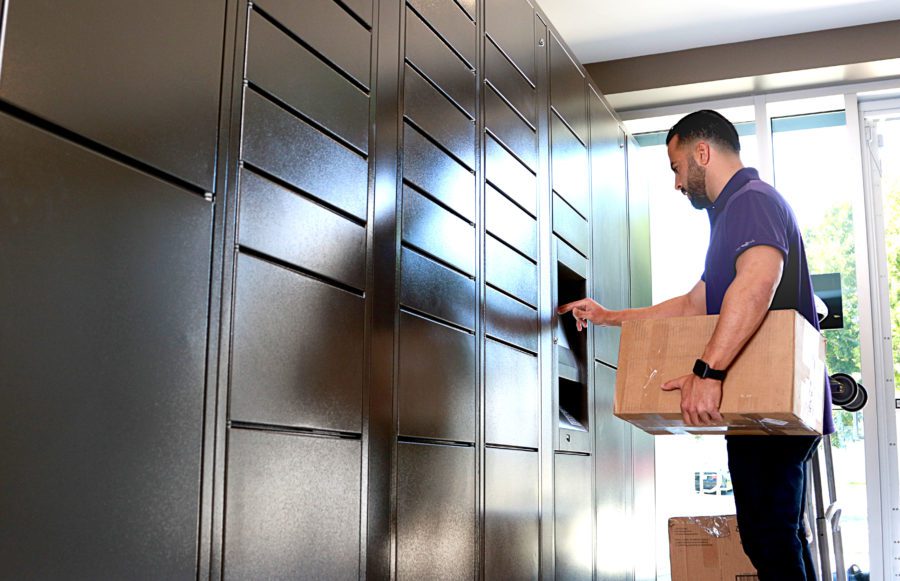
University
How to Attract College Students Online
Written by: Parcel Pending
6 Min Read
Published: March 6, 2021
Updated: March 29, 2023
Many higher education institutions are facing new challenges when it comes to attracting prospective students. Whereas college fairs and campus tours were once the norm, today campus recruiting is all online all the time. So, how do you market to college students? As we continue to navigate health and safety guidelines associated with in-person events, here are the top strategies for effectively marketing your college to prospective students online.
Create Virtual Tours
A virtual campus tour is your secret weapon for marketing to prospective students, especially for out-of-state or international students. Between March 13 and April 13, nearly 1.4 million people viewed a virtual campus tour produced by YouVisit, a virtual tour company. High school seniors are taking these tours at a rate 228% higher than they were a year ago1.
A good tour works to introduce a prospective student to the culture, internships, professors, and the college campus. A great tour includes question and answer sessions with professors, college graduates, and other students. It’s also important to immerse visitors into the experience with multimedia dimensions, interactive elements, and strong calls-to-action.
Highlighting amenities and facilities on college campuses so that students can see themselves living on campus is also key. Virtual walkthroughs should showcase the student union, the bookstore, dining options, and even parcel locker solutions available or intelligent lockers for student use. An electronic locker solution can provide a contactless method for shipping to college dorms or distributing key documents, campus passes, books, and campus mail. Accessible 24/7, students no longer need to wait in long lines to pick up packages from the mailroom creating a better student experience. This is especially important as student consumer trends indicate a shift to almost entirely online purchasing.
An investment in a tour today pays off in the future, too, even as some semblance of normal returns. College marketers note that the virtual tours marketing strategy also works to introduce family members to the school, thereby gaining buy-in for the school choice.
Invest in Paid Digital Marketing
With over 5,300 colleges and universities in the United States, it’s critical to be easily found on the web by students. A recent study reports that 73% of marketing leaders are increasing their marketing efforts and are reallocating their efforts towards digital marketing2. Of those, 28% indicated they would add more online advertising, 18% would invest in more content marketing, 15% would pursue more organic growth, and 12% are looking to enhance their social media marketing strategy. Pay-per-click, search engine optimization, and retargeted ads are all available tools at a college marketer’s disposal.
Leverage Social Media Platforms
While some might joke that students seem to have been born with a phone in their hands, the statistics almost seem to bear it out.
- Teens spend an average of seven hours and 22 minutes on their phones each day excluding homework2. With schoolwork, books, and music added, the total jumps to almost 10 hours per day!
- TikTok became the fastest-growing new app for American teens in 20192.
- 60% of TikTok users were age 16 to 242.
- YouTube was the most used social media platform among teens in 2019, followed by Instagram and Snapchat6,7,8.
In short, if you want to market to Gen Z college students, you must meet them where they are: online and preferably on social networks like TikTok and Twitter.
Savvy marketers for higher education institutions are creating specialized social media accounts as a recruitment strategy so that they can craft appropriate and targeted information for prospective students. A football social media account explains win/loss records, upcoming games, safety protocols, and player profiles whereby an admissions social media account highlights upcoming deadlines, secrets to writing an essay, and how to complete an application for the university. Northeastern University follows this strategy as does the Massachusetts Institute of Technology (MIT) which boasts a whopping 450 social media channels for its various departments and teams!
The University of Queensland’s Instagram account regularly shares study-from-home tips, providing good information for potential students9. Indiana University encourages students who are mostly still at home to create and share videos allowing for easy sharing and distribution.
Of course, central to all social media is creating the all-important hashtag. A dedicated hashtag allows college social media managers to more easily repost and share user-generated content (UGC). This strategy then allows for a more authentic feed as student-generated and university-created social media posts reside side-by-side.
Don’t forget the videos and photos! Tweets with images enjoyed a 36% increase in clicks and a 55% increase in overall leads10. Meanwhile, a video is 10X more likely to be retweeted11.
Employ Student Ambassadors and Influencers
Allowing college students to manage a few social media channels builds trust with prospective students. You can create rules in advance, specify a set period of time as the social media manager, and allow them to use their real name and voice. Videos such as a “day in the life of a college student” are an excellent marketing campaign strategy. Student ambassadors are also a win/win for you and the students: students are able to build their personal brand, and the university gets an authentic, relatable testimonial on college student life for prospective students.
It’s also a good idea to check in with new college graduates and their social media channels. Since Millennial and Gen Z students rely on word-of-mouth so much more strongly than any generation, successful and influential alumni, for example, can help with student recruitment. Recruiting recent graduates to share their stories via social media and virtual events can play a pivotal role in converting potential candidates to the next class of incoming students.
Enter and Tout Rankings by Major Publications
A good showing in rankings draws interest from potential students and their parents. This year, for the first time, major brand name universities are skipping college ranking studies. Harvard Business School, Stanford Graduate School of Business, and Pennsylvania’s Wharton School all chose not to enter the Economist’s or the Financial Times’ ranking of business schools, citing the extra work that it required during the pandemic. As a result, lesser-known schools are moving up the rankings and drawing more student interest. The University of Wisconsin, for example, moved up a whopping 27 places in The Economist’s listing, sliding into the top twenty. “To be top 20 in a respected ranking, that has some extra clout for us,” said Assistant Dean Blair Sanford12.
In today’s battle for students, the admissions office must redirect funds to online marketing efforts. Only with the appropriate information, virtual tours, and social media channels will colleges and universities be able to showcase the unique elements of their schools.
Parcel Pending by Quadient is the leading provider of mail and package management solutions for higher education institutions in the United States and Canada. With nearly 3 million packages successfully delivered monthly, we offer a wide range of solutions that ensure the simple and secure delivery and retrieval of mail, packages, and online orders.
Let us take care of your deliveries so you can take care of your students, faculty, and staff. Learn more about our university parcel management solutions here.
Sources:
- Jaschik, Scott. Inside Higher Ed. Virtual Tours Grow, but Will They Have Same Impact?. (2020, April 20). https://www.insidehighered.com/admissions/article/2020/04/20/virtual-tours-boom-will-they-have-same-impact.
- Koetsier, John. Forbes. 250 CMOs On Coronavirus: Marketers ‘On The Front Line Of The Economy’. (2020, April 15). https://www.forbes.com/sites/johnkoetsier/2020/04/15/250-cmos-on-coronavirus-marketers-on-the-front-line-of-the-economy/?sh=1ff4b1b211a8.
- Jacobo, Julia. ABC News. Teens spend more than 7 hours on screens for entertainment a day: Report. (2019, October 29). https://abcnews.go.com/US/teens-spend-hours-screens-entertainment-day-report/story?id=66607555.
- Smart Social. TikTok App: Safety Guide for Parents and Educators. (2020, September 21). https://smartsocial.com/tiktok-app-guide-parents/.
- Iqbal, Mansoor. Business of Apps. TikTok Revenue and Usage Statistics. (2021, February 10). https://www.businessofapps.com/data/tik-tok-statistics/.
- Tanskova, H. Statista. Reach of leading social networking sites used by teenage and young adult online users in the United States as of 3rd quarter 2020. (2021, January 28). https://www.statista.com/statistics/199242/social-media-and-networking-sites-used-by-us-teenagers/.
- Smart Social. Instagram App Guide for Parents in 2021. (2021, January 26). https://smartsocial.com/instagram/.
- Ochs, John. Smart Social. Snapchat App Parent Guide. (2021, February 10). https://smartsocial.com/snapchat/.
- The University of Queensland. “7 tips to study from home”. Instagram, 3 Mar. 2020, https://www.instagram.com/p/B-OwBQ0pD9F/.
- Leaning, Brittany. HubSpot. A/B Test Finds 55% Increase in Leads When Images Added to Tweets [New Data]. (2017, February 1). https://blog.hubspot.com/marketing/tweet-images-improve-lead-gen-ht.
- Window, Marissa. Twitter Business. 5 data-driven tips for scroll stopping video. (2018). https://business.twitter.com/en/blog/5-data-driven-tips-for-scroll-stopping-video.html.
- Thomas, Patrick. The Wall Street Journal. What’s the Best Business School? For This Year’s M.B.A. Rankings, It’s Not Who You Think. (2021, February 15). https://www.wsj.com/articles/whats-the-best-business-school-for-this-years-m-b-a-rankings-its-not-who-you-think-11613394000?.



